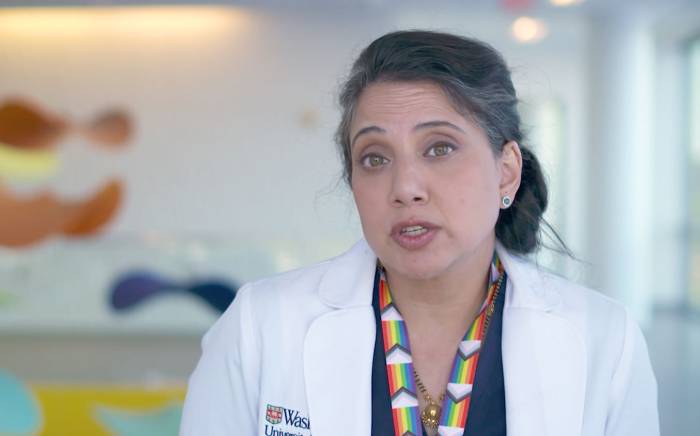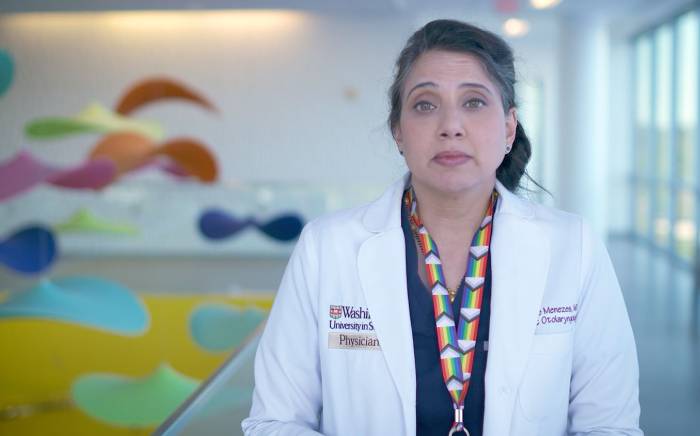Differences of sex development is a phrase used for conditions in which a person is born with reproductive or sexual anatomy that doesn’t fit the typical definitions of female or male. The word “intersex” is also used to describe people with differences of sex development.
For example, differences of sex development may include:
- Atypical genitalia (also called ambiguous genitalia), such as an unusually small penis or unusually large clitoris
- Differences in the development of the gonads (testes and ovaries), or internal reproductive and urinary organs (such as the uterus, bladder and urethra)
- Unusual chromosome patterns
Many people receive a diagnosis of differences of sex development when they are newborns. However, people who do not have noticeable, external differences may not discover their condition until puberty, or until they try to conceive a child.
What Causes Differences of Sex Development?
A variety of factors can affect a developing baby and lead to differences in sex development. In many cases, doctors don’t know the cause. In other cases, differences occur because of specific, identifiable chromosome or DNA differences that happen during fetal development.
For additional information, see our Differences of Sex Development FAQ.
Differences of Sex Development Conditions
DSD conditions may be classified into three major groups:
- 46,XY DSD
- 46,XX DSD
- Sex chromosome DSD
The following are some of the common and rare DSD conditions treated by the Differences of Sex Development Program at St. Louis Children’s Hospital:
- 5-alpha-reductase deficiency is a lack of the enzyme 5-alpha reductase. This enzyme is needed to help the penis and testes complete their development. This condition is inherited.
- Amenorrhea is when a person has not started having menstrual periods by age 16, but is otherwise experiencing normal growth and secondary sex characteristics (e.g., pubic hair or enlarged breasts).
- Androgen insensitivity syndrome, or AIS, is an inherited syndrome where infants are not responsive to androgens (testosterone). People with this syndrome have an atypical combination of genetic makeup and physical traits.
- Clitoromegaly is a condition where the clitoris is larger than normal. This can be caused by hormone problems before or after birth, or for other reasons. If a clitoris is much larger than normal, it may resemble a penis.
- Congenital adrenal hyperplasia is an inherited condition that affects the adrenal gland. Babies born with congenital adrenal hyperplasia (CAH) cannot make enough of the hormone cortisol, which helps control energy, sugar levels, blood pressure, and the body’s response to injury or illness.
- Denys-Drash syndrome (or Drash syndrome) is a syndrome in which very young children experience kidney failure and abnormal development of the reproductive organs and urinary system.
- Epispadias or hypospadias are when the opening of the urethra (the tube that carries urine from the bladder) is not at the tip of the penis. In people with epispadias, the urethra opens on the front side of the penis; in people with hypospadias, the urethra opens on the back side of the penis. In either case, the penis may curve downward (chordee) and the foreskin may have an atypical appearance.
- Frasier syndrome is a rare disorder that includes atypical development of genitalia and the urinary tract.
- Failure of pubertal development occurs when people do not go through puberty at the typical time. This can happen for many reasons, including hormone problems, problems in the genitourinary system (the reproductive organs and urinary system), or genetic conditions.
- Gonadal dysgenesis is when the gonads do not develop in a typical manner and/or do not function properly. People can be born with either complete or partial gonadal dysgenesis.
- Microphallus is a penis that is smaller than typical, usually defined as being below the first percentile in size. A microphallus can be caused by hormone problems before or after birth, a genetic syndrome, or for other reasons.
- MRKH (Mayer-Rokitansky-Küster-Hauser) syndrome causes the vagina and uterus to be underdeveloped or absent.
- Turner syndrome is a genetic condition that causes people to be shorter than others and prevents them from undergoing normal puberty. It occurs in people assigned female at birth.
- Undescended testes is a condition in newborns when one or both of the testes have not passed down into the scrotal sac.
DSD Tests and Treatments
The DSD team at St. Louis Children’s Hospital may recommend imaging, tests, exams or evaluations to confirm a diagnosis and/or recommend a treatment plan.
Please see Differences of Sex Development Tests and Treatments to learn more about potential tests and treatments.









